A few issues ago I penned a piece about using Rapala Count Downs to catch bass in rivers and creeks. It was a technique I was having a lot of success on at the time and I got a real kick out of taking a lure which most anglers would commonly think of as being pretty much a specialist ‘trout’ lure and finding out that it was ideal for tempting Aussie bass when they were shut down and sulking deep in the snags.
Anyway, while I’m happy to report that those little bits of Finnish balsa are still doing the trick for me on ‘wild’ fish, by varying my approach a little, I’ve also been able to enjoy some surprisingly good results in our stocked impoundments.
I guess if you look at the reasons why the Count Down approach is so successful in rivers and creeks, it makes perfect sense that they should work just as well in the dams. You see, the 5cm and 7cm sinking Rapala minnows have a nice skinny profile and that makes them a pretty good imitation of any number of small gudgens, glaxia or other baitfish that bass gorge on. Most importantly, they offer a completely different profile to the bigger bodied sinking rattlers like Jackals and Cordell Rattlin Spots, which have become so popular with a lot of bass anglers. Impoundments fish see a lot of lures these days and soon wise up to certain lures or presentations.
The other really important feature of Count Downs is that they sink. What’s more, they don’t plummet to the bottom like heavy rattlers do. Instead, they sink at around 30cm per second. This slightly slower sink rate allows the fish to have a good long look at them as they flutter slowly towards the bottom and that little extra time in the strike zone can often be enough to convince the fish to eat them.
The natural looking finishes they come printed in probably don’t hurt in this regard either and while I’ve never seen any baby rainbow trout in the bass streams around here, that doesn’t stop the fish from finding them attractive.
One of the reasons why minnow lures don’t generally get a lot of use for impoundment bass, is that most of them float or suspend. This can be handy when the fish are active during change of light periods, where a violent jerkbait retrieve can be deadly, unfortunately it’s not all that often that you find the fish sitting up high in the water column.
With a sinking minnow, you can fish them as deep as you like and this allows you to extend your fishing time until much later in the morning. You just have to be patient enough to let them sink a bit longer and it’s quite easy to fish them in that highly productive strike zone just above the bottom of most dams.
If you are fishing any more than 5-6m of water these lures are probably not going to be your first choice, as you will spend too much time waiting for them to get down to the fish. However, unless you are targeting deep schools of bass, it’s unlikely you’d be fishing in those sorts of depths.
I’ve certainly had my greatest success in water around 3-4m deep. At that depth, it only takes a count of a 10-12 to get your lure right down to the bottom. That might not sound like long but it can feel like ages when you are there watching the line like a hawk and waiting for it to go slack so you know your lure is sitting on the bottom.
Where sinking lures really shine is fishing around weed beds and vertical timber. If you can cast your lure along the outside edge of a weed curtain and let it sink down beside the vegetation it will be lucky to make it all the way to the bottom. Bass love to patrol areas like this and the almost helpless look of a little minnow slowly wafting towards the bottom is usually too much for them to resist.
If your lure does make it all the way to the lake floor, don’t despair. Some of the largest bass I have caught using this technique have come from right down in the depths. All you need to do is give the lure a slight jerk, and then a bit of a slow roll and let it sink again. This has the effect of drawing the lure up off the bottom into the fish’s vision, swimming it along and then letting it slowly drift back to the bottom again. It’s a pretty good impersonation of a sick or injured baitfish and you will find that the vast majority of the hits will come as the lure is sinking, rather than when you are moving it.
You will also find that the lure will often be way down the back of the fish’s throat. They don’t just bite these lures, they try to swallow them. When you see how deep they often get taken, you get an idea of how effective the lure motion must look to the fish. One thing’s for sure, they generally don’t make too many mistakes when they decide to grab the lure.
If you’ve ever fished lakes with lots of weed, you will know how hard it is to fish a rattler over vegetation. Due to their weight, as soon as they come in contact with weeds, they start to sink into them and you end up with a lure covered in greenery. To keep them from hanging up all the time, you usually need to wind them faster than you want.
One of the benefits of fishing with a sinking minnow is that they don’t weigh anywhere near as much as a rattler. That means that when you are letting them sink, they will often waft down until the come to rest on top of the weeds and they just sit there, rather than plunging down into the vegetation.
You’ll still get hung up occasionally but you’ll probably be surprised how much easier they are to fish right up in the shallows. If you strike a period where the water level has recently risen, you’ll probably be amazed at how many bass will work over the top of the submerged vegetation, which is also a perfect area to fish with a sinking minnow.
One of the biggest surprises to come out of this approach has been the number of large fish I’ve taken on sinking minnows. I would have thought that the larger and noisier rattlers would attract the biggest bass but that hasn’t been the case at all. Surprisingly, the bigger fish seem to find the quiet and subtle presentation of the sinking minnow to be just the ticket and, when they hit them, they really mean business. I’ve taken to using a pair of artery forceps to help pull the hook points out of the back of the fish’s throat so that I can release them without too much surgery.
The same problems you run into when chasing bass on small lures still apply in the dams. Small minnow lures can only carry small hooks and big bass have a nasty habit of destroying small trebles. Luckily, as I’ve already mentioned, most of the hookups seem to happen well inside the fish’s mouth, and there is plenty of room there for the hook points to get a hold and they will generally stay put as long as you don’t try and bullock the fish to the net or drag them out of the weeds.
Facts
Gear Box
Whether in rivers or lakes, my favourite bass spinning outfit is a Yoshi SP-Snapper – SP72225. The rod is matched to a high quality 2500 size spin reel loaded with 3kg Schnieder braid.
While a smaller and lighter outfit may be preferable for casting with such small minnows, opting for a more powerful combination provides good peace of mind when pulling larger bass out of heavily weeded areas. As the lures tend to get taken well back in the fish’s mouth, a slightly heavier leader of around 6kg or so can also help prevent bust-offs.
Weedbed Bass (eps)
The dotted line should give you a good indication of the sort of path you want your lure to take. Hits will most likely come as the lure is sinking.
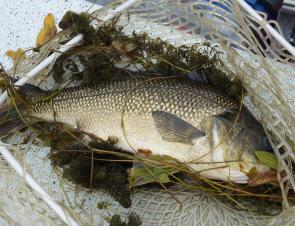
This beast of a bass is one of many which have shown an interest in the author’s small sinking minnows fished around the weedbeds in his local lake. As you can see, it had to be dragged out of the weeds so it could be brought onboard to have its photo tak
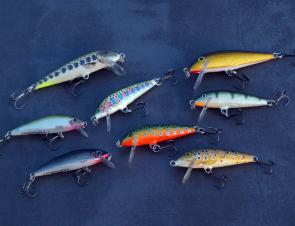
Rapala CD 5 and 7 minnows in a range of finishes. The two Xrap Count Downs on the bottom left have been particularly popular with the author’s local lake dwelling bass population.

Just under 50cm (fork length) of lake bass which munched one of the new 5 cm Rapala Xrap Count Downs.
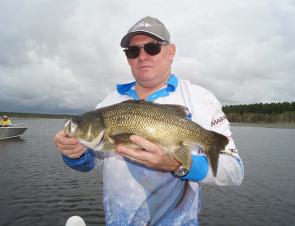
Small lures sometimes produce big fish, and sinking minnows seem to do it regularly.
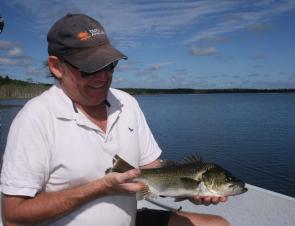
Lake bass are suckers for small sinking minnows like Rapala Count Downs.
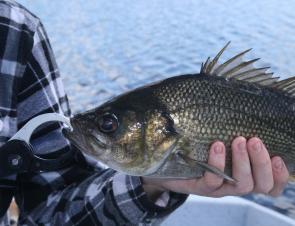
Lake bass are suckers for small sinking minnows like Rapala Count Downs.

Here’s an ideal weedline to prospect with sinking minnows. The overcast day is pretty good too as it will help keep the fish biting that little bit longer.

Weedbeds interspersed with standing time makes a great place to toss a few sinking minnows.

Weedbeds interspersed with standing time makes a great place to toss a few sinking minnows.
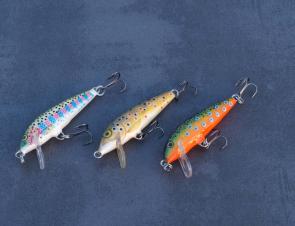
These baby trout imitations do a great job in bass water if you know how to make the most of their abilities.




